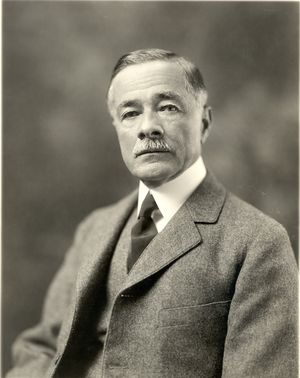John J. Carty
John J. Carty: Biography
Born: 14 April 1861
Died: 27 December 1932
John Joseph Carty was born at Cambridge, MA, 14 April 1861, son of Henry and Elizabeth (O´Malley) Carty. He received his early education in Cambridge. At the time he had finished his preparatory studies for entrance to college he was obliged to abandon his school work indefinitely, because of serious trouble with his eyesight.
Carty entered the service of the Bell Telephone Co. in 1879, when the telephone had just been invented. His first work was in Boston, MA. Under his direction was installed the first multiple switchboard in Boston, which was at that time the largest ever put into use. For the "express" telephone system, peculiar to that city, he designed and installed a switchboard which was the first metallic circuit multiple board to go into service. In 1887 Carty took charge of the cable department of the Western Electric Co. in the East, with headquarters in New York City. In this position he studied cable manufacture and laying, and introduced a number of improvements, having charge of all of the important cable-laying projects which where carried on at that time in the East. One of Carty´s engineering developments resulted in cutting in half the cost of cable manufacture. He then took charge of the switchboard department of the Western Electric Co. for the East, and under his direction were installed most of the larger switchboards of that period.
In 1889 Carty entered the service of the Metropolitan Telephone and Telegraph Co. (then New York Telephone Co.), for the purpose of organizing all the technical departments, building up its technical staff, and reconstructing the entire plant of the company -converting it from grounded circuits, overhead and series switchboards to metallic circuits placed underground and to bridging switchboards. The telephone system constructed upon his plans and under his direction was one of the most advanced in the world at that time, in terms of efficiency and scope.
Carty made an exhaustive investigation into the nature of the disturbances to which telephone lines are subjected, and gave the first public account of his work in a paper entitled, "A New View of Telephone Induction," read before the Electric Club of New York city on Nov. 21, 1889. In this paper he showed the overwhelming preponderance of electrostatic induction as a factor in producing cross-talk. The article gave directions for determining a silent or neutral point where no cross-talking may be heard, and described original experiments showing how to distinguish between electrostatic and electromagnetic induction in telephone lines. In March, 1891, Carty made additional contributions to the knowledge of this subject in a paper before the American Institute of Electrical Engineers, entitled, "Inductive Disturbances in Telephone Circuits." Prior to his work on the subject, the number of telephone stations which could be operated upon one line was greatly restricted because of the impediment offered to the voice currents by the presence of the signaling bells, and on account of the inductive disturbances which these bells caused. These conditions made it impracticable to extend the telephone to the rural districts owing to the prohibitive expenses involved in providing each customer with a circuit of his own. Carty devised a mechanism known as the "bridging bell" whereby any number of stations that might be required could be placed upon one line without in any way impairing the transmission of speech or introducing disturbing noises. The simplicity and cheapness of the device and the extraordinary success which attended its working resulted in an immediate extension of the telephone into rural districts and the placing of the telephone in the homes of millions of farmers in America and abroad which had formerly been isolated. For this achievement the Franklin Institute of Philadelphia conferred upon him the Edward Longstreth Medal of Merit in 1902.
In 1907 Carty was made Chief Engineer of the American Telephone and Telegraph Company. In 1908, he visited California, which was then recovering from the San Francisco earthquake. Keenly feeling his separation from business associates, he publically announced A. T. & T.’s intention to complete a transcontinental telephone line in time for San Francisco’s Panama Pacific International Exposition in 1915. A flurry of research and construction followed. On 25 January 1915, the promise was met in grand style when Alexander Graham Bell, in New York, and Thomas Watson, in San Francisco, participated a coast to coast phone call amid great pomp and celebration. Carty’s expertise was also utilized by the American armed forces in World War I, and he was able to help provide telephone service that greatly aided communication in that critical moment of conflict.
Carty was a member of the Society for the Promotion of Engineering Education, the Society for the Promotion of Industrial Education, the American Institute of Electrical Engineers, the New York Electrical Society, and the Society of Arts. He received many honors throughout his life, among them the Franklin Medal (1916), the Edison Medal of the American Institute of Electrical Engineers (1917) 'For his work in the science and art of telephone engineering', and the John Fritz Medal (1928). The Emperor of Japan decorated him with the Order of the Rising Sun in 1909, and with the Imperial Order of the Sacred Treasure in 1912, in recognition of his achievements as an engineer, and in view of the services he rendered to the Japanese government in connection with electrical engineering matters.
Carty was married on 8 August 1891, to Marion Mount Russell, and had one son, John Russell. Carty died, from complications from surgery, on 27 December 1932.
